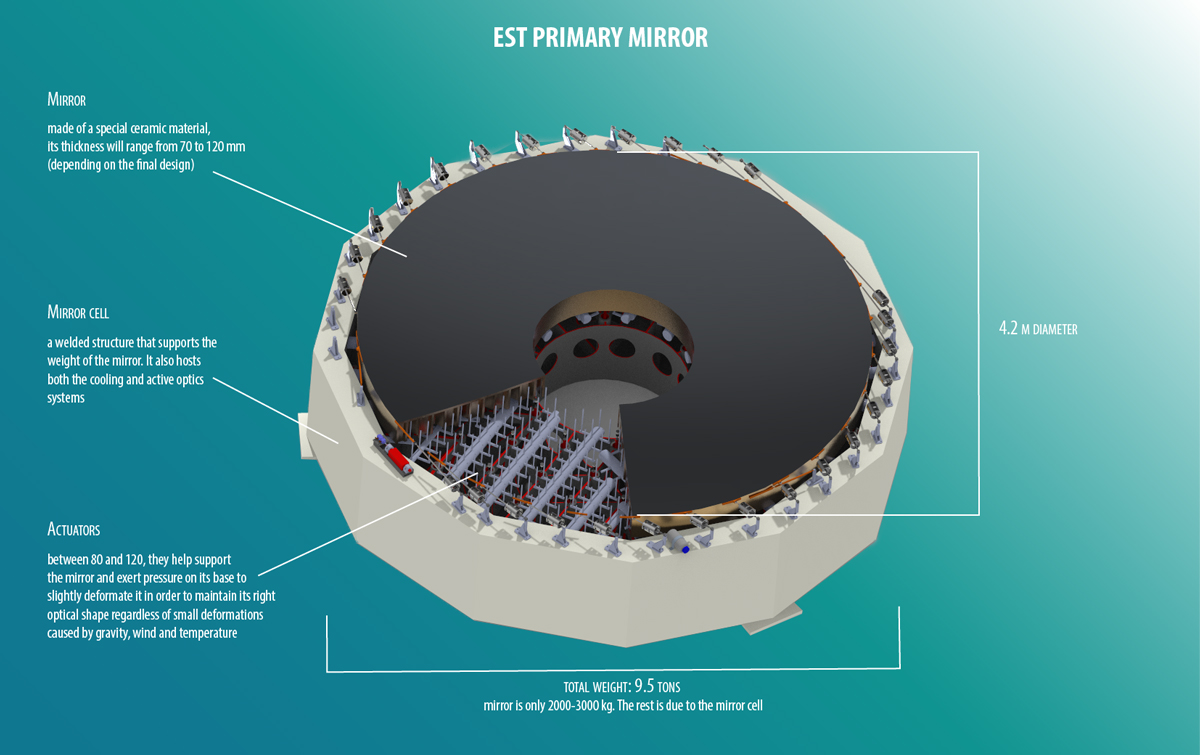The European Solar Telescope will have a primary mirror of 4.2 metres in diameter, allowing scientists to observe even the smallest details on the Sun thanks to its resolving power. However, beyond its optical capabilities, the EST primary mirror is also a fine work of engineering in itself.
 Recreation of the EST primary mirror. The open section allows to see where the actuators will be located.
Recreation of the EST primary mirror. The open section allows to see where the actuators will be located.
Size matters, especially for a telescope: “a larger mirror means more light and better resolution”, explains Jorge Sánchez Capuchino, Optical Design Lead at the European Solar Telescope. With a monolithic mirror of 4.2 metres in diameter, EST will have unprecedented resolution and light collecting power, allowing scientists to observe even the smallest details of the Sun.
Such large size means the weight is also large: a total of 9.5 tons. The bulk of the weight corresponds to the mirror cell, a welded steel structure which serves both as the mirror support and as a container for the cooling and active optics systems. In fact, the mirror itself will be quite light: 2500-3000 kilograms and a thickness between 70 and 250 mm (depending on whether the final design goes for a solid meniscus blank or a lightweight one).
However, a big size is not enough: controlling the shape and temperature of the mirror is also important in order to prevent image distortions and local seeing (turbulence caused by an excessive temperature of the telescope itself). In accounting for these variables, the EST primary mirror reveals itself as a fine work of engineering.
Correcting for shape and temperature
Environmental forces like gravity, wind and temperature produce deformations in the curvature of the mirror. Although invisible to the naked eye, these deformations nevertheless affect image quality, so the ability of the mirror to maintain the correct curvature is of paramount importance. To do so, the EST primary mirror relies on active optics, also known as figure control.
“Figure control consists of between 80 and 120 actuators that help support the weight of the mirror and, in addition, exert pressure on its base, ensuring that it maintains the right shape at all times, despite the environmental conditions”, explains Ángel Mato, a mechanical engineer working on the primary mirror development. The corrections applied by the actuators will be calculated in real time thanks to a computer that detects even the smallest deviations from the ideal mirror shape.
“Active optics only compensates for distorting forces that change relatively slow, from 30 seconds to 5 minutes”, points out Mato (for quicker changes, the telescope relies on adaptive optics). Still, it is enough for a mirror that, despite its stiffness, is also very light for a telescope: a thickness between 70 and 250 mm and 2500-3000 kilograms weight.
The whole structure is also designed to avoid local seeing (turbulence caused by an excessive temperature of the telescope components) via a cooling system that will prevent the mirror from getting hotter than it should. The allowed temperature range is between +0.5º and -1º degrees in relation to the environment —although this range increases by 0.5º if the wind is faster than 5 metres per second. By the way, the mirror cell will also have its own cooling system, allowing for a +1.5º to -2º temperature range in relation to the environment.
A Formula 1 mirror
When asked whether telescope mirrors are like the ones everybody has at home, Jorge Sánchez Capuchino answers with another question: “Is a Formula 1 racing car, a car?"
Indeed, the mirror of a telescope is to your home mirror what a Formula 1 car is to your family car. That is, they’re based on the same principles (substrate, blank, reflecting coating), but each of the components of a telescope mirror is improved to the best of its capacity: they all have a special coating offering a 99% reflectivity in the intended wavelength range (which, in the case of the European Solar Telescope, goes from the visible to the near infrared) plus, they are made of a ceramic crystal with a very low thermal coefficient, so the effect of the heat is minimised. Moreover, their surfaces are polished to have a roughness of less than 2 nanometres, so they do not introduce additional errors and the optical quality remains as high as possible.
